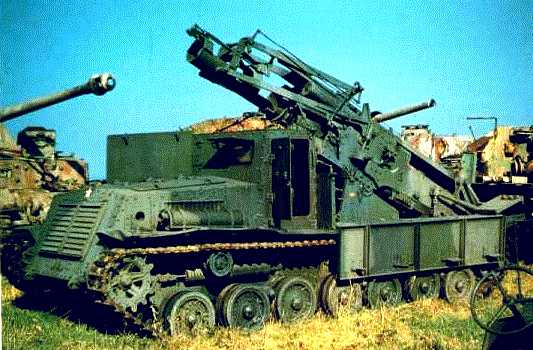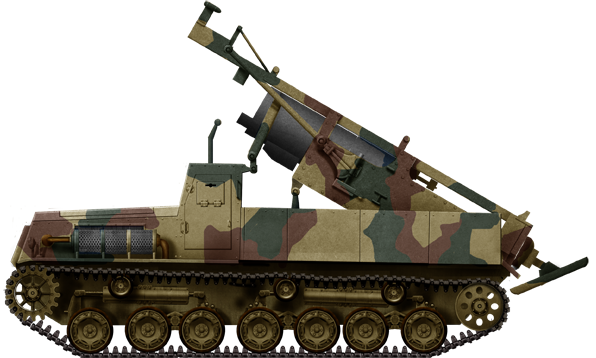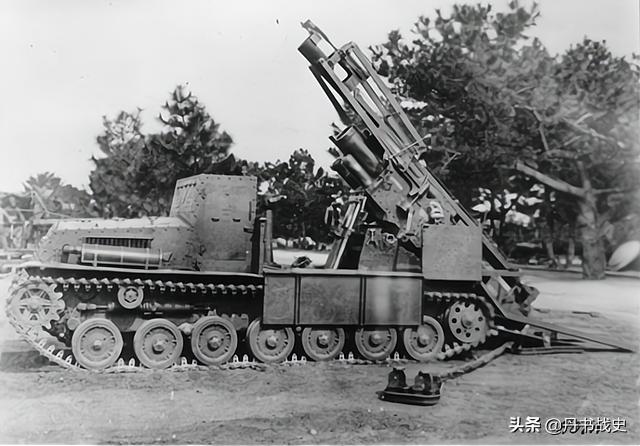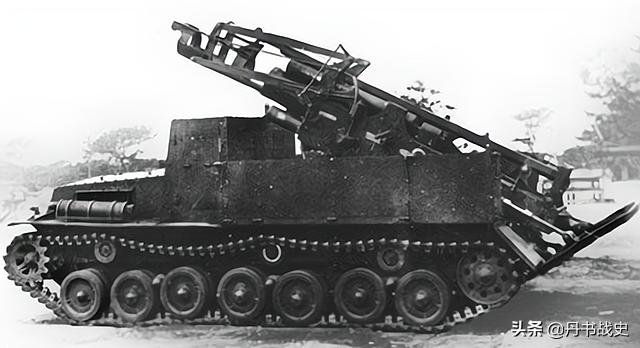The Type 4 Ha-To (試製四式重迫撃砲 ハト for "Shisei yon-shiki jū-hakugekihō hato" was a self-propelled mortar developed by the Imperial Japanese Army in World War II. It was designed as a mobile fire support platform in late 1943, making use of the Type 3, 300 mm (12-inches) heavy mortar already in the IJA inventory. Until then it never was mounted on a chassis. Only a single prototype and three serial vehicles were ever built in 1943-44, never used.

The Type 3 mortar had a muzzle velocity probably similar to that of the Type 98 320mm mortar, about 150 m/s. Tests shown a distance of 3,145 meters was possible, fangerously close to the front line but adapted to the fight in these pacific islands, like at Peleliu.
In the crew, the driver and commander stayed in an armored cab, and the latter useed the short range radio to receive target indications by ground troops. The remaining 5 consisted in a gunner and 4 loader, and they used a special equipment to lift the shells, but the rate of fire was still of several minutes.
The first prototype was completed in late 1944, taken to the Imperial Japanese Army Academy for intensive testing which concluded favourably. It was established that of well deployed, it would have been an effective weapon. But at that stage in the war, in early 1945, it was expensive to produce, and the Japanese Army Technical Bureau preferred the solution of self-propelled multiple rocket launchers instead, as the IJA already obtained from the Germans plans for the Sd.Kfz.4 Panzerwerfer.
Nevertheless, three more units were produced, based on the modified prototype before the surrender of Japan in 1945, but none ever saw combat. They stayed stationed in Japan, and would have been used if Operation Olympic would have taken place.
One was captured to the Aberdeen Proving Ground and tested by the US military ordnance but reports were negative and it was later sent to the scrapyard.

Design
The Type 4 Ha-To consisted on a modified chassis based on the Type 4 Chi-To medium tank, and combined with elements from the Type 4 Chi-So armored medium tracked carrier. Its armor was way thinner than the Chi-To while the engine compartment was relocated to the front, as the drive sprockets, the idlers being swapped to the rear. This obliged to reorganize the vehicle, which had a cabin built after the engine hood, for the driver and two operators, the rest bein seated in folding bunks in the flatbed behind, on which was bolted the cradle for the mortar mount.Protection
Th vehicle was lightly protected, with 25 mm on the nose, and 12 mm on the sides. It had no weapon installed apart the large mortar. The crew of seven depended on their own personal weapons for close defence. Some sources says it could receive a Type 97 machine gun. It was considered as a rear echelon vehicle anyway.Mobility
Given the original Type 4 Chi-To tank, the engine was a water-cooled 6-cylinder Mitsubishi gasoline unit rated for only 115 hp (86 kW), for a power/weight of 12 hp/ton. The chassis also comprised seven roadwheels per side, foubled to rest on the single-pin track assembly and three return rollers. These suspension used bell crank for a maximum speed of 40 km/h.About the Type 3 12-inch mortar
The type 3 mortar was apparently developed as modified, lighter Type 98 330 mm mortar version (the latter was ground-based, used at Iwo Jima). It had a range of 3,000 m (1.9 mi), launching a 170 kg (374 lb) projectile. The mortar weighted 1.5 tons, and to preserve the vehicle's balance could not be elevated more than 50 degrees.The Type 3 mortar had a muzzle velocity probably similar to that of the Type 98 320mm mortar, about 150 m/s. Tests shown a distance of 3,145 meters was possible, fangerously close to the front line but adapted to the fight in these pacific islands, like at Peleliu.
Type 4 Ha-To specifications | |
| Dimensions | 6.8 x 2.4 x 2.75 meters |
| Total weight, battle ready | 14.3 tons |
| Crew | 7 (driver, commander/radio, pointer, 4 loaders) |
| Propulsion | water-cooled 6-cyl Mitsubishi gasoline 115 hp (86 kW) |
| Speed | bell crank suspensions 40 km/h |
| Armor | 12–25 mm RHA |
| Armament | Type 3 300mm mortar |
| Range | 200 km (160 miles) |
| Total production |
Development History
The mortar used the space reserved to the hold deck of the former troop carrier's hull. When firing it was to be lowered until hitting the ground, with the 50° elevation to artificially increase range. This was to avoid the center of gravity of being too far behind. Adjustment range was managed by the pointer, but traverse was very limited. Indeed, the vehicle was at first roughly aligned with the target, followed by minor adjustments.In the crew, the driver and commander stayed in an armored cab, and the latter useed the short range radio to receive target indications by ground troops. The remaining 5 consisted in a gunner and 4 loader, and they used a special equipment to lift the shells, but the rate of fire was still of several minutes.
The first prototype was completed in late 1944, taken to the Imperial Japanese Army Academy for intensive testing which concluded favourably. It was established that of well deployed, it would have been an effective weapon. But at that stage in the war, in early 1945, it was expensive to produce, and the Japanese Army Technical Bureau preferred the solution of self-propelled multiple rocket launchers instead, as the IJA already obtained from the Germans plans for the Sd.Kfz.4 Panzerwerfer.
Nevertheless, three more units were produced, based on the modified prototype before the surrender of Japan in 1945, but none ever saw combat. They stayed stationed in Japan, and would have been used if Operation Olympic would have taken place.
One was captured to the Aberdeen Proving Ground and tested by the US military ordnance but reports were negative and it was later sent to the scrapyard.





Read More
Tomczyk, Andrzej (2003). Japanese Armor Vol. 3. AJ Press.Tomczyk, Andrzej (2007). Japanese Armor Vol. 5. AJ Press.
Trewhitt, Philip (1999). Armoured Fighting Vehicles. Dempsey-Parr.
Links
inf.news/englobalsecurity.org
Type 4 Ha-To wiki
Video
On secretprojects.co.uk
on www3.plala.or.jp
3D model

WW2 Tanks




























WW2 tanks posters

All Tiger tanks liveries.

Panther liveries and variants

WW2 Armour - All tanks











Tanks aces and single tanks series

Find more there

Museums, Movies, Books & Games
The Tanks and Armor in pop culture
Tanks and armored vehicles in general are only really grasped when seen first person: The mass, the scale, it's all there. Explore also the way tanks were covered in the movie industry, in books and in video games.Movies:
Best tanks movie on warhistoryonline.com
On imdb.com
On bestsimilar.com/
miltours.com
liveabout.com/
watchmojo.com
Video Games:
pcgamesn.com
historyhit.com
levvvel.com
vg247.com/best-tank-games
mmobomb.com/
alienwarearena.com

